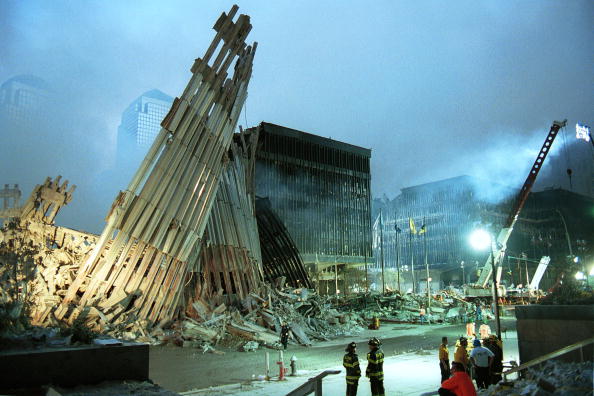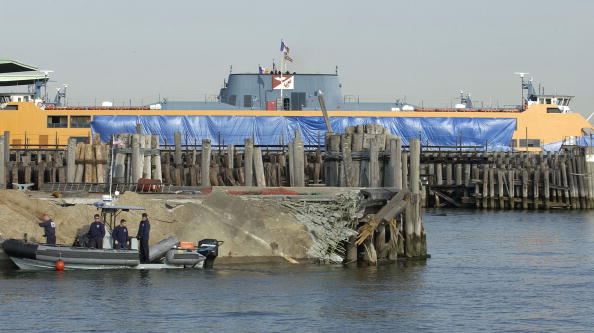Biggest New York Events Of The 2000s
New York events both large and small would forever be eclipsed by the happenings of September 11, 2001. Despite the enormity and ongoing aftermath of that day, New Yorkers continued to display the spunk and spirit they are known for. Although for many life would never normalize, events throughout the decade continued to unfold, shaping the city and those who live here.
 Early morning light hits the smoke and wreckage of the World Trade Center September 13, 2001 in New York City, two days after the twin towers were destroyed when hit by two hijacked passenger jets. (Photo by Chris Hondros/Getty Images)
Early morning light hits the smoke and wreckage of the World Trade Center September 13, 2001 in New York City, two days after the twin towers were destroyed when hit by two hijacked passenger jets. (Photo by Chris Hondros/Getty Images)
The Towers Fall: September 11, 2001
The attack of 9/11 seared a new realization about the nature of evil into the American consciousness. The attack was caused by 19 Islamic al-Qaeda militants, from Saudi Arabia and other Arabic nations. The militants hijacked four planes and carried out suicide missions against U.S. targets. Two of the planes were flown into the two towers of the World Trade Center, toppling them. One flew into the Pentagon in Washington, D.C. and one was felled by passengers, thwarting the attack and causing the plane to crash in a Pennsylvania field. The intended target of the forth plane remains unknown. Over 3,000 innocent lives were taken that day, including close to 400 first responders.
 Firefighters hang the American flag on top of some of the wreckage of American Airlines flight 587 November 13, 2001 in the Rockaway section of Queens, New York. (Photo by Shaul Schwarz/Getty Images)
Firefighters hang the American flag on top of some of the wreckage of American Airlines flight 587 November 13, 2001 in the Rockaway section of Queens, New York. (Photo by Shaul Schwarz/Getty Images)
A Plane Crashes in Queens: November 12, 2001
Despite initial fears that American Airlines Flight 587, and the 260 souls aboard were the latest victims of a terrorist attack, the plane's crash was ultimately determined to have been caused by an overuse of the rudder controls and human error. The airbus, bound for the Dominican Republic, crashed into the sleepy neighborhood of Belle Harbor, an area known for its high occupancy by first responders and their families.
Those in the neighborhood, still reeling from the September 11th attacks, watched in horror as the plane exploded and burned on their streets, taking five unsuspecting Belle Harbor residents along with it. The plane narrowly missed the popular Irish pub and firemen's hangout, The Harbor Light. A total of 265 people died as a result of the crash, which was devastating to all New Yorkers and the Dominican community in particular.
 Police officials survey a damaged pier at the Staten Island ferry terminal October 16, 2003 on Staten Island. (Photo by Mike Hvozda/NTSB via Getty Images)
Police officials survey a damaged pier at the Staten Island ferry terminal October 16, 2003 on Staten Island. (Photo by Mike Hvozda/NTSB via Getty Images)
A Ferry Crash Kills 11: October 15, 2003
It should have been just another trip home for the 1,500 passengers of the Andrew J. Barberi, a ferry boat bound for the docks of St. George, Staten Island. Instead, the boat, suddenly angled away from its standard berth and at full speed, crashed into a concrete maintenance pier nearby. The boat's main deck, stuffed full of passengers waiting to disembark, was practically shredded by the impact of the pier, which pierced it. Panic ensued yet the boat remained in the water for 20 minutes until it was turned and docked in another berth. Ten people were left dead and 71 were injured, some catastrophically. Another fatality occurred as a result of the crash two months later, bringing the total number of victims to 11. Despite a city ordinance requiring two pilots to be on duty at all times during docking, only one was at the helm. The pilot, Richard Smith, was said to have been asleep at the controls due to his use of several painkillers, which caused drowsiness. He attempted suicide several times after the crash, but was unsuccessful. Smith pled guilty to manslaughter and was sentenced to 18 months in prison. Because the ferry company employing him did not adhere to city rules, its director, Patrick Ryan, was also sentenced to one year and a day in prison, on similar charges.
 A trader rubs his face while working on the floor of the New York Stock Exchange October 7, 2008 in New York City. (Photo by Mario Tama/Getty Images)
A trader rubs his face while working on the floor of the New York Stock Exchange October 7, 2008 in New York City. (Photo by Mario Tama/Getty Images)
The Great Recession Begins: December 2007
Considered the worst economic global downturn since the end of WWII, the most recent recession lasted 18 months from December of 2007 until June of 2009, according to the U.S. National Bureau of Economic Research. The years preceding the recession were earmarked by the emergence of risky loan practices and the granting of sub-prime mortgages, which decreased in value when the housing market bubble burst. Mortgage payment defaults escalated dramatically and people lost their homes in horrifying numbers. Investment and commercial banking institutions, both in the U.S. and in Europe, suffered dramatic losses and many faced bankruptcy, causing a dramatic de-escalation in international trade and a huge spike in unemployment rates. Median household wealth fell by at least 25 percent or more in many geographic areas, some of which have still not fully recovered.
 People walk along a path on the newly-opened second section of the High Line park in on June 7, 2011 in New York City. (Photo by Spencer Platt/Getty Images)
People walk along a path on the newly-opened second section of the High Line park in on June 7, 2011 in New York City. (Photo by Spencer Platt/Getty Images)
New Yorkers Don Their Walking Shoes: 2009
Where else but in New York can a dilapidated stretch of rail line become an idyllic walkway? The High Line, an abandoned section of railway suspended 30 feet above Chelsea, was targeted for demolition decades ago. Still under construction but mostly open to the public, the High Line now features wild foliage, park benches, children's play areas and never before seen, sweeping views. The self-seeded landscape is comprised of over 200 wild species of plant life. Upon completion, the High Line will include the New Whitney Museum along its southern tip. That same year, sections of Broadway and Herald Square were closed to traffic and a pedestrian mall designed as part of the Green Light for Midtown Project.
Corey Whelan is a freelance writer in New York. Her work can be found at Examiner.com.



